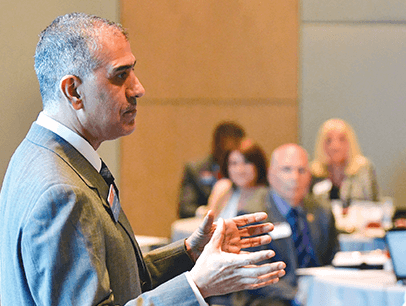
In Toastmasters, we know that we can find inspiration, or at least speech topics, in almost all experiences in life. Maybe you had an experience with a new hobby, or going out on a limb (or wing) to try something new. For me, it came by way of skydiving. How are the topics of Toastmasters, leadership, and skydiving possibly related? It may not be as much of a stretch as you think.
Full Vision to Success –
A person getting ready to jump out of a plane at 12,000 feet is thinking a lot of things, and leadership is likely not one of them. However, during a recent skydiving experience, as I sat at the edge of the door ready to jump, it was obvious to me that my field of vision was very limited. When I was out of the plane and free falling, the view was expansive and breathtaking. Shortly after the jump, while working on a leadership presentation, that image came back to me, and I realized that leadership is directly related to the process of skydiving. Each of these two experiences depend greatly on having a vision, both figuratively and literally.The skydiver needs to make sure the sky is clear enough to see the desired target for landing. They must be able to gauge their entire surroundings and not just the limited view from the side of the plane and the edge of the door. Likewise, a leader must have a vision of where the team is going and present that vision convincingly to their followers. The leader must know what success looks like and have a strategy for how to get there. Then they must share that vision.
Inviting the team to join the leader on the journey is key. As a leader in Toastmasters, your community, or your workplace, are you inviting people to join you on the adventure? Or have you been the one invited along the path to success?
A Step-by-Step Process –
Everything we learn in life, we learn step by step. learning to crawl, walk, talk, and become a great leader. The skydiver knows to follow a series of steps required for a successful jump. The airplane must be in safe condition and be flown by a competent pilot. The weather must be right. The parachute must be properly packed, and many other details must be confirmed.In Toastmasters we understand that leaders are made. The step-by-step process to effective leadership, in many cases, can have a small beginning step. Maybe someone said, “I believe in you,” and that was the first time you started to see yourself as a leader. Often the best leaders come from someone seeing something in them that they didn’t see for themselves. Perhaps you took a small role in your club, and when that was successful, you looked to the next, slightly larger step. You repeated the process to a larger leadership role and found success. Maybe you are reading this article and starting to think about the steps to leadership in your club and beyond.
Are leaders successful every time they take a step? No, even the most successful leaders are not, but what they do know is that sometimes it is important to take a step back, review the situation, adjust the vision if needed, then take that next step forward.
Think back to where you were in your Toastmasters or work experience five years ago. Or one year ago. Is it different from where you stand today? It is surely different from where you will stand in five years, if you choose to keep moving. What is your next step?
Who Is Packing Your Parachute? –
In a solo jump, the skydiver must make sure the parachute is correctly packed, as their life depends on it. In a tandem jump, the jump master is generally the one who packs the parachute and is in total control of when the ripcord is pulled. The person who is jumping with the jump master may not even touch the parachute but knows the jump master has the expertise needed for success. Leadership is very much the same process, like when an effective leader delegates a project to a team member who may be a subject matter expert.Many people have opportunities to step up to leadership but are afraid to take the chance. The opportunities may be in your club, District, community engagement, or the workplace as part of a team or management. What if you don’t know enough? What if you are asked a question and do not know how to respond? What if … fill in the blank with a favorite reason for not taking that step toward leadership. You don’t have to know everything, you just need to know the people who do, or the places to find the answers.
Often the best leaders come from someone seeing something in them that they didn't see for themselves.
Captain Charlie Plumb is a retired United States Navy fighter pilot who spent six years in a Vietnam prison camp after his plane was shot down. He tells his story about meeting the young man one day who packed his parachute for the fateful flight. Although he never really thought about his parachute packer, he says that after he was shot down, he thought about that person quite often. Without the skill and dedication that young man had in packing the parachute, Plumb may not have survived to tell his story. He was the pilot, not the parachute packer, but both roles are vital for a successful mission, especially when something does not go as planned.
The parachute is worn on the back of the skydiver (or pilot) as they jump. Who do you depend on for your success as a leader? Who has your back and packs your parachute? And, maybe just as important, whose parachute do you pack?
Finding Your Voice and Inspiring Others to Find Theirs –
Skydiving jump masters may or may not train others to succeed in jumping. They may or may not train to do tandem jumps with people who want to leave the parachute packing to them. But for leaders, helping others to succeed plays a pivotal role.A leader must know who they are, what they stand for, and what they believe in. Not everyone wants to lead, but a good leader will help someone find their voice and potential for leadership within the team, and help them develop their skills.
What about your role in Toastmasters leadership? Do you see the vision? Have you taken the first step, or the next step to leadership? Are you a parachute packer? Do you know how to find one? Have you found your voice in leadership? Congratulations if you have and are already serving or have served in Toastmasters leadership. If not, what’s stopping you?
Tammy A. Miller, DTM is a member of State College Toastmasters in State College, Pennsylvania. She is a Past International Director, and a Toastmasters Accredited Speaker, professional auctioneer, and speech coach. She is also the co-author of The Joyful Journey of Hospital Clowning and the author of The Lighter Side of Breast Cancer Recovery. Learn more at www.tammyspeaks.com.



 Previous
Previous
 Previous Article
Previous Article

